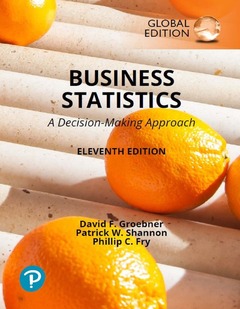Description
Business Statistics: A Decision Making Approach, Global Edition (11th Ed.)
Authors: Groebner David, Shannon Patrick, Fry Phillip
Language: English
Subject for Business Statistics: A Decision Making Approach, Global...:
79.21 €
In Print (Delivery period: 14 days).
Add to cart864 p. · 21.7x27.6 cm · Paperback
Description
/li>Contents
/li>Biography
/li>Comment
/li>
Business Statistics: A Decision-Making Approach, 11th Edition, is an introductory text for students who do not necessarily have an extensive mathematics background but who need to understand how statistical tools and techniques are applied in business decision making. Concepts and techniques presented in a systematic and ordered way make this text accessible to all students. The authors draw from their years of experience as consultants, educators, and writers to show the relevance of statistical techniques in realistic situations through engaging examples.
This text seamlessly integrates computer applications, such as Microsoft Excel and XLSTAT, with textual examples and figures, always focusing on interpreting the output. The goal is for students to be able to know which tools to use, how to apply the tools, and how to analyze results for making decisions.
- The Where, Why, and How of Data
- Graphs, Charts, and Tables: Describing Your Data
- Describing Data Using Numerical Measures
1 - 3 SPECIAL REVIEW SECTION
- Introduction to Probability
- Discrete Probability Distributions
- Introduction to Continuous Probability Distributions
- Introduction to Sampling Distributions
- Estimating Single Population Parameters
- Introduction to Hypothesis Testing
- Estimation and Hypothesis Testing for Two Population Parameters
- Hypothesis Tests and Estimation for Population Variances
- Analysis of Variance
8 - 12 SPECIAL REVIEW SECTION
- Goodness-of-Fit Tests and Contingency Analysis
- Introduction to Linear Regression and Correlation Analysis
- Multiple Regression Analysis and Model Building
- Analyzing and Forecasting Time-Series Data
- Introduction to Nonparametric Statistics
- Introducing Business Analytics
- Introduction to Decision Analysis (Online)
- Introduction to Quality and Statistical Process Control (Online)
APPENDICES A to P
About our authors
David F. Groebner is Professor Emeritus of Production Management in the College of Business and Economics at Boise State University. He has bachelor's and master's degrees in engineering and a Ph.D. in business administration. After working as an engineer, he has taught statistics and related subjects for 27 years. In addition to writing textbooks and academic papers, Groebner has worked extensively with both small and large organizations, including Hewlett-Packard, Boise Cascade, Albertson's, and Ore-Ida. He has worked with numerous government agencies, including Boise City and the U.S. Air Force.
Patrick W. Shannon, Ph.D. is Dean and Professor of Supply Chain Operations Management in the College of Business and Economics at Boise State University. In addition to his administrative responsibilities, he has taught graduate and undergraduate courses in business statistics, quality management, and production and operations management. In addition, Dr. Shannon has lectured and consulted in the statistical analysis and quality management areas for more than 20 years. Among his consulting clients are Boise Cascade Corporation, Hewlett-Packard, PowerBar, Inc., Potlatch Corporation, Woodgrain Millwork, Inc., J.R. Simplot Company, Zilog Corporation, and numerous other public- and private-sector organizations. Shannon has co-authored several university-level textbooks and has published numerous articles in such journals as Business Horizons, Interfaces, Journal of Simulation, Journal of Production and Inventory Control, Quality Progress, and Journal of Marketing Research. He obtained B.S. and M.S. degrees from the University of Montana and a Ph.D. in statistics and quantitative methods from the University of Oregon.
Phillip C. Fry is a professor in the College of Business and Economics at Boise State University, where he has taught since 1988. Phil received his B.A. and M.B.A. degree
Hallmark features of this title
- Step-by-step approach includes How to Do It lists that summarize major techniques and fundamental concepts; Textual Examples give step-by-step details, helping students to follow solution techniques.
- Real-world business applications marked by icon cover areas from accounting and finance to supply chain management.
- Chapter Cases enable students to apply statistical tools. Students must define a problem, choose the appropriate tool, apply it and write a summary report.
- Chapter-opening Quick Prep Links suggest ways to prepare for topics discussed.
- Excel Functions boxes provide the Excel function needed to complete a specific test or calculation.
- Problems and exercises are organized by Skill Development, Business Applications, and Computer Software Exercises.
These books may interest you

Statistical Thinking in Business 214.69 €

Business Statistics using Excel 77.67 €


